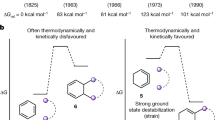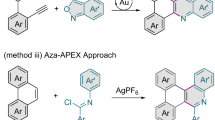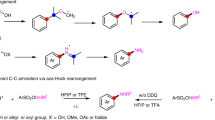Abstract
Since its discovery in 1825, benzene has served as one of the most used and indispensable building blocks of chemical compounds, ranging from pharmaceuticals and agrochemicals to plastics and those used in organic electronic devices. Benzene has six hydrogen atoms that can each be replaced by different substituents, which means that the structural diversity of benzene derivatives is intrinsically extraordinary. The number of possible substituted benzenes from n different substituents is (2n + 2n2 + 4n3 + 3n4 + n6)/12. However, owing to a lack of general synthetic methods for making multisubstituted benzenes, this potentially huge structural diversity has not been fully exploited. Here, we describe a programmed synthesis of hexaarylbenzenes using C–H activation, cross-coupling and [4+2] cycloaddition reactions. The present method allows for the isolation and structure–property characterization of hexaarylbenzenes with distinctive aryl substituents at all positions for the first time. Moreover, the established protocol can be applied to the synthesis of tetraarylnaphthalenes and pentaarylpyridines.
This is a preview of subscription content, access via your institution
Access options
Subscribe to this journal
Receive 12 print issues and online access
$259.00 per year
only $21.58 per issue
Buy this article
- Purchase on Springer Link
- Instant access to full article PDF
Prices may be subject to local taxes which are calculated during checkout





Similar content being viewed by others
References
Faraday, M. On new compounds of carbon and hydrogen, and on certain other products obtained during the decomposition of oil by heat. Phil. Trans. R. Soc. Lond. 115, 440–466 (1825).
Taylor, R. D., MacCoss, M. & Lawson, A. D. G. Rings in drugs. J. Med. Chem. 57, 5845–5859 (2014).
Burnside, W. Theory of Groups of Finite Order (Cambridge Univ. Press, 1897).
Polya, G. & Reade, R. C. Combinatorial Enumerations of Groups, Graphs, and Chemical Compounds (Springer, 1987).
Hoye, T. R., Baire, B., Niu, D., Willoughby, P. H. & Woods, B. P. The hexadehydro-Diels–Alder reaction. Nature 490, 208–212 (2012).
Itami, K. & Yoshida, J. Platform synthesis: a useful strategy for rapid and systematic generation of molecular diversity. Chem. Eur. J. 12, 3966–3974 (2006).
Itami, K. et al. Diversity-oriented synthesis of multisubstituted olefins through the sequential integration of palladium-catalyzed cross-coupling reactions. 2-Pyridyldimethyl(vinyl)silane as a versatile platform for olefin synthesis. J. Am. Chem. Soc. 123, 11577–11585 (2001).
Itami, K., Ohashi, Y. & Yoshida, J. Triarylethene-based extended π-systems: programmable synthesis and photophysical properties. J. Org. Chem. 70, 2778–2792 (2005).
Itami, K., Tonogaki, K., Nokami, T., Ohashi, Y. & Yoshida, J. Palladium-catalyzed convergent synthesis and properties of conjugated dendrimers based on triarylethene branching. Angew. Chem. Int. Ed. 45, 2404–2409 (2006).
Itami, K., Mineno, M., Muraoka, N. & Yoshida, J. Sequential assembly strategy for tetrasubstituted olefin synthesis using vinyl 2-pyrimidyl sulfide as a platform. J. Am. Chem. Soc. 126, 11778–11779 (2004).
Itami, K., Kamei, T. & Yoshida, J. Diversity-oriented synthesis of tamoxifen-type tetrasubstituted olefins. J. Am. Chem. Soc. 125, 14670–14671 (2003).
Itami, K., Yamazaki, D. & Yoshida, J. Pyrimidine-core extended π-systems: general synthesis and interesting fluorescent properties. J. Am. Chem. Soc. 126, 15396–15397 (2004).
Yanagisawa, S., Ueda, K., Sekizawa, H. & Itami, K. Programmed synthesis of tetraarylthiophenes through sequential C–H arylation. J. Am. Chem. Soc. 131, 14622–14623 (2009).
Tani, S., Uehara, T. N., Yamaguchi, J. & Itami, K. Programmed synthesis of arylthiazoles through sequential C–H couplings. Chem. Sci. 5, 123–135 (2014).
Geng, Y., Fechtenkötter, A. & Müllen, K. Star-like substituted hexaarylbenzenes: synthesis and mesomorphic properties. J. Mater. Chem. 11, 1634–1641 (2001).
Tomović, Z. et al. Star-shaped oligo(p-phenylenevinylene) substituted hexaarylbenzene: purity, stability, and chiral self-assembly. J. Am. Chem. Soc. 129, 16190–16196 (2007).
Kobayashi, K., Sato, A., Sakamoto, S. & Yamaguchi, K. Solvent-induced polymorphism of three-dimensional hydrogen-bonded networks of hexakis(4-carbamoylphenyl)benzene. J. Am. Chem. Soc. 125, 3035–3045 (2003).
Hiraoka, S., Nakamura, T., Shiro, M. & Shionoya, M. In-water truly monodisperse aggregation of gear-shaped amphiphiles based on hydrophobic surface engineering. J. Am. Chem. Soc. 132, 13223–13225 (2010).
Hiraoka, S., Hisanaga, Y., Shiro, M. & Shionoya, M. A molecular double ball bearing an AgI–PtII dodecanuclear quadruple-decker complex with three rotors. Angew. Chem. Int. Ed. 49, 1669–1673 (2010).
Steeger, M. & Lambert, C. Charge-transfer interactions in tris-donor–tris-acceptor hexaarylbenzene redox chromophores. Chem. Eur. J. 18, 11937–11948 (2012).
Traber, B. et al. Hexasubstituted donor–acceptor benzenes as nonlinear optically active molecules with multiple charge-transfer transitions. Chem. Eur. J. 10, 1227–1238 (2004).
Tanaka, Y., Koike, T. & Akita, M. 2-Dimensional molecular wiring based on toroidal delocalization of hexaarylbenzene. Chem. Commun. 46, 4529–4531 (2010).
Shukla, R., Lindeman, S. V. & Rathore, R. A polyaromatic receptor with an ethereal fence that directs K+ for effective cation–π interaction. J. Am. Chem. Soc. 128, 5328–5329 (2006).
Chen, L., Hernandez, Y., Feng, X. & Müllen, K. From nanographene and graphene nanoribbons to graphene sheets: chemical synthesis. Angew. Chem. Int. Ed. 51, 7640–7654 (2012).
Seyler, H., Purushothaman, B., Jones, D. J., Holmes, A. B. & Wong, W. W. H. Hexa-peri-hexabenzocoronene in organic electronics. Pure Appl. Chem. 84, 1047–1067 (2012).
Zhang, W. et al. Supramolecular linear heterojunction composed of graphite-like semiconducting nanotubular segments. Science 334, 340–343 (2011).
Campeau, L-C. et al. C2, C5, and C4 azole N-oxide direct arylation including room-temperature reactions. J. Am. Chem. Soc. 130, 3276–3277 (2008).
Campeau, L-C. et al. Palladium-catalyzed direct arylation of azine and azole N-oxides: reaction development, scope and applications in synthesis. J. Am. Chem. Soc. 131, 3291–3306 (2009).
Joo, J. M., Touré, B. B. & Sames, D. C–H bonds as ubiquitous functionality a general approach to complex arylated imidazoles via regioselective sequential arylation of all three C–H bonds and regioselective N-alkylation enabled by SEM-group transposition. J. Org. Chem. 75, 4911–4920 (2010).
Shibahara, F., Yamaguchi, E. & Murai, T. Direct arylation of simple azoles catalyzed by 1,10-phenanthroline containing palladium complexes: an investigation of C4 arylation of azoles and the synthesis of triarylated azoles by sequential arylation. J. Org. Chem. 76, 2680–2693 (2011).
Yamaguchi, J., Yamaguchi, A. D. & Itami, K. C–H bond functionalization: emerging synthetic tools for natural products and pharmaceuticals. Angew. Chem. Int. Ed. 51, 8960–9009 (2012).
Segawa, Y., Maekawa, T. & Itami, K. Synthesis of extended π-systems through C–H activation. Angew. Chem. Int. Ed. 54, 66–81 (2015).
Wencel-Delord, J. & Glorius, F. C–H bond activation enables the rapid construction and late-stage diversification of functional molecules. Nature Chem. 5, 369–375 (2013).
Ackermann, L., Vicente, R. & Kapdi, A. Transition-metal-catalyzed direct arylations of (hetero)arenes via C–H bond cleavage. Angew. Chem. Int. Ed. 48, 9792–9826 (2009).
Davies, H. M. L. & Manning, J. R. Catalytic C–H functionalization by metal carbenoid and nitrenoid insertion. Nature 451, 417–424 (2008).
Tang, R-Y., Li, G. & Yu, J-Q. Conformation-induced remote meta-C–H activation of amines. Nature 507, 215–220 (2014).
Cheng, C. & Hartwig, J. F. Rhodium-catalyzed intermolecular C–H silylation of arenes with high steric regiocontrol. Science 343, 853–857 (2014).
McNally, A., Haffemayer, B., Collins, B. S. L. & Gaunt, M. J. Palladium-catalysed C–H activation of aliphatic amines to give strained nitrogen heterocycles. Nature 510, 129–133 (2014).
Fujiwara, Y. et al. Practical and innate carbon–hydrogen functionalization of heterocycles. Nature 492, 95–99 (2012).
Chen, M. S. & White, M. C. Combined effects on selectivity in Fe-catalyzed methylene oxidation. Science 327, 566–571 (2010).
Ogliaruso, M. A., Romanelli, M. G. & Becker, E. I. Chemistry of cyclopentadienones. Chem. Rev. 65, 261–367 (1965).
Saito, S. & Yamamoto, Y. Recent advances in the transition-metal-catalyzed regioselective approaches to polysubstituted benzene derivatives. Chem. Rev. 100, 2901–2916 (2000).
Yanagisawa, S., Sudo, T., Noyori, R. & Itami, K. Direct C–H arylation of (hetero)arenes with aryl iodides via rhodium catalysis. J. Am. Chem. Soc. 128, 11748–11749 (2006).
Ueda, K., Yanagisawa, S., Yamaguchi, J. & Itami, K. A general catalyst for the β-selective C–H bond arylation of thiophenes with iodoarenes. Angew. Chem. Int. Ed. 49, 8946–8949 (2010).
Kirchberg, S. et al. Oxidative biaryl coupling of thiophenes and thiazoles with arylboronic acids through palladium catalysis otherwise difficult C4-selective C–H arylation enabled by boronic acids. Angew. Chem. Int. Ed. 50, 2387–2391 (2011).
Thiemann, T. et al. Cycloaddition of thiophene S-oxides to allenes, alkynes and to benzyne. New J. Chem. 27, 1377–1384 (2003).
Himeshima, Y., Sonoda, T. & Kobayashi, H. Fluoride-induced 1,2-elimination of o-trimethylsilylphenyl triflate to benzyne under mild conditions. Chem. Lett. 1211–1214 (1983).
McKay, C. S., Moran, J. & Pezacki, J. P. Nitrones as dipoles for rapid strain-promoted 1,3-dipolar cycloadditions with cyclooctynes. Chem. Commun. 46, 931–933 (2010).
Burke, M. D. & Schreiber, S. L. A planning strategy for diversity-oriented synthesis. Angew. Chem. Int. Ed. 43, 46–58 (2004).
Jandeleit, B., Schaefer, D. J., Powers, T. S., Turner, H. W. & Weinberg, W. H. Combinatorial materials science and catalysis. Angew. Chem. Int. Ed. 38, 2494–2532 (1999).
Acknowledgements
This work was supported by the ERATO programme from JST (K.I.), the Funding Program for Next Generation World-Leading Researchers from JSPS (220GR049 to K.I.), a Grant-in-Aid for Scientific Research on Innovative Areas ‘Molecular Activation Directed toward Straightforward Synthesis’ (25105720 to J.Y.) and KAKENHI (25708005 to J.Y.) from MEXT. The authors thank S. Hagihara, T. Yoshidomi, K. Muto and A. Miyazaki (Nagoya University) for discussions and critical comments. K. Kuwata (Nagoya University) is acknowledged for assistance with mass spectroscopy. ITbM is supported by the World Premier International Research Center (WPI) Initiative, Japan.
Author information
Authors and Affiliations
Contributions
K.I. and J.Y. conceived the concept and directed the project. S.S. conducted experiments. Y.S. conducted X-ray crystal structure analysis. K.I. and J.Y. prepared the manuscript with feedback from others.
Corresponding authors
Ethics declarations
Competing interests
The authors declare no competing financial interests.
Supplementary information
Supplementary information
Supplementary information (PDF 18860 kb)
Supplementary information
Crystallographic data for compound 9A (CIF 24 kb)
Supplementary information
Crystallographic data for compound 11a (CIF 33 kb)
Supplementary information
Crystallographic data for compound 13 (CIF 23 kb)
Supplementary information
Crystallographic data for compound 15 (CIF 28 kb)
Supplementary information
Crystallographic data for compound 17b (CIF 26 kb)
Rights and permissions
About this article
Cite this article
Suzuki, S., Segawa, Y., Itami, K. et al. Synthesis and characterization of hexaarylbenzenes with five or six different substituents enabled by programmed synthesis. Nature Chem 7, 227–233 (2015). https://doi.org/10.1038/nchem.2174
Received:
Accepted:
Published:
Issue Date:
DOI: https://doi.org/10.1038/nchem.2174



